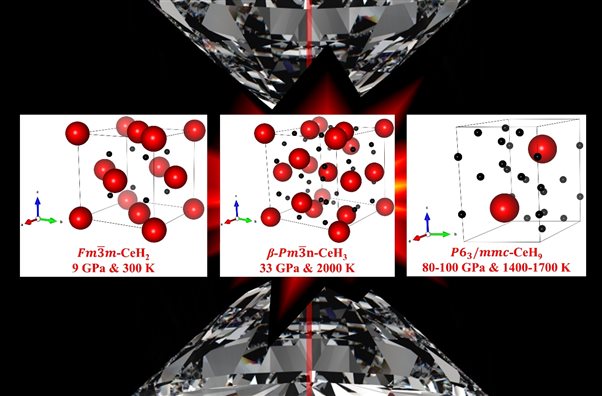Synthesis of superconducting cerium superhydride with 3D atomic hydrogen sublattice - Dr. Nilesh P. Salke
OCTOBER 2, 2019
Hydrogen-rich superhydrides are very promising candidates to achieve superconductivity close to room temperature. Most of the superhydrides stabilize at very high pressures. A team of scientist led by Dr. Nilesh P. Salke at the Center for High Pressure Science and Technology Advanced Research (HPSTAR) has discovered the cerium superhydride CeH9 at 80-100 GPa with laser heating. CeH9 possess the atomic hydrogen sublattice which is the closest analogue to metallic hydrogen at 100 GPa. This study is published in recent Nature Communications.
Compression of hydrogen to achieve metallic hydrogen is one of the most fascinating topics in high-pressure science, particularly due to the room temperature superconductivity predicted for metallic hydrogen. Similarly, hydrogen-rich superhydrides (MHx, x > 6) are also expected to become room temperature superconductor, thankfully at pressures lower than pure metallic hydrogen. Many superhydrides with unusually high-hydrogen content and high-Tc were predicted to become stable at high pressure using crystal structure prediction methods. Although a significant amount of experimental work has been done on hydrides, the field of superhydrides is largely unexplored. Recently, lanthanum superhydride LaH10 was discovered experimentally to be stabilized at high pressure of 170 GPa with record high-Tc of 250 K. HPSTAR researchers in collaboration with others have carried the experimental and theoretical work on the cerium-hydrogen system to synthesize the various cerium hydride phases.
The elemental reaction between cerium and hydrogen carried to synthesize new cerium hydride phases. Cerium superhydride CeH9 phase was successfully synthesized at 80-100 GPa with the help of pulse laser heating. A new phase of CeH3 with β-UH3 type structure has also synthesized at 33 GPa with pulse laser heating. Theoretical calculations were carried by Prof. Artem Oganov’s group to understand the structure and dynamical stability and superconducting properties. Careful analysis of experimental and theoretical data concluded that CeH9 crystallized in clathrate structure with space group P63/mmc structure, in which each cerium atom is surrounded by dense 3-dimensional atomic hydrogen cage. Comparison of nearest H-H distance in CeH9 with simulated atomic metallic hydrogen and other poly/superhydrides suggested that hydrogen sublattice of CeH9 at 100 GPa is the closest analogue to atomic hydrogen. Estimated Tc of CeH9 is 105-117 K at 200 GPa and 63-75 K at 100 GPa.
“High-pressure and high-temperature experiments involving hydrogen are very challenging, but the synthesis of cerium superhydride CeH9 phase below 100 GPa is certainly very promising,” said Dr. Nilesh P. Salke, “Pressure of around 100 GPa is quite achievable these days and discovery of superhydride phase at this pressure will certainly motivate other researchers to investigate this system by other techniques. In particular, it would be interesting to investigate the superconducting properties of CeH9 to verify the predicted Tc.”

Caption: Pressure-temperature conditions for the synthesis of various cerium hydride phases. Red and black symbols represent cerium and hydrogen atoms, respectively.
This study was carried in collaboration with Profs Jung-Fu Lin, Jianshi Zhou and Yaguo Wang at the University of Texas – Austin, US, Prof. Artem Oganov at Skolkovo Institute of Science and Technology, Russia, Dr. M. Mahdi Davari Esfahani at Stony Brook University, US, Ivan Kruglov at Moscow Institute of Physics and Technology, Russia, Drs Eran Greenberg and Vitaly Prakapenka at the University of Chicago, US, and Prof. Youjun Zhang at Sichuan University, China.
近几年硫-氢,铼-氢体系中记录性的超导转变温度的发现,使得富氢化合物的研究成为了科学家们研究的热点课题。理论及实验指出富氢化合物由于非氢元素对氢会产生预压作用,而相对更容易实现金属化,及室温超导。北京高压科学研究中心的Nilesh P. Salke博后带领的研究小组借助金刚石对顶砧及激光加热技术80-100GPa下合成了金属铈的超氢化合物。CeH9具有笼状结构、呈现金属性。在100GPa时,其氢原子的亚晶格在已知氢化物中最接近金属氢,他们进一步的理论计算表明,CeH9在100GPa时将转变为超导体,其超导转变温度为63-75 K。由于CeH9的合成压力远远低于铼氢化物等的合成条件,因此该研究预示着可以在低压下有望合成更多的高温超导体。
